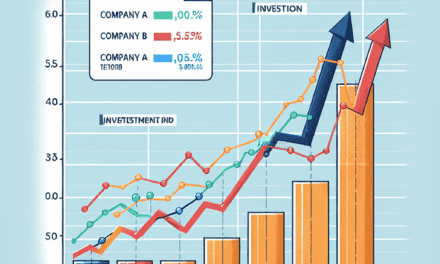“Unlock Tomorrow’s Market: Essential Insights Before the Opening Bell”
Introduction
Before the stock market opens, investors and traders must consider several key insights to make informed decisions. Understanding pre-market trends is crucial, as they often set the tone for the day’s trading activities. Economic indicators, such as employment data, inflation rates, and GDP growth, can significantly influence market sentiment and should be closely monitored. Additionally, global events, including geopolitical tensions or economic developments in major economies, can impact market dynamics. Corporate earnings reports and announcements also play a vital role, as they provide insights into company performance and future prospects. Lastly, technical analysis of market charts and patterns can offer valuable guidance on potential price movements. By considering these insights, market participants can better navigate the complexities of the stock market and optimize their investment strategies.
Pre-Market Economic Indicators
Before the stock market opens, investors and analysts alike turn their attention to a variety of pre-market economic indicators that can provide valuable insights into the day’s potential market movements. These indicators, which are released before the opening bell, serve as a barometer for the economic environment and can significantly influence investor sentiment and trading strategies. Understanding these indicators is crucial for making informed investment decisions.
One of the most closely watched pre-market indicators is the employment report, which provides data on job creation, unemployment rates, and wage growth. This report is a key measure of economic health, as strong job growth typically signals a robust economy, while rising unemployment may indicate economic challenges. Investors often scrutinize these figures to gauge consumer spending potential, as employed individuals are more likely to spend, thereby driving economic growth. Consequently, a positive employment report can lead to increased investor confidence and a bullish market outlook.
In addition to employment data, inflation indicators such as the Consumer Price Index (CPI) and the Producer Price Index (PPI) are also pivotal. These indices measure the average change in prices over time for goods and services, providing insight into inflationary pressures within the economy. Rising inflation can erode purchasing power and lead to higher interest rates, which may negatively impact stock prices. Therefore, investors pay close attention to these indicators to assess the likelihood of monetary policy adjustments by central banks, which can have far-reaching effects on market dynamics.
Moreover, the release of corporate earnings reports before the market opens can significantly sway investor sentiment. These reports offer a glimpse into a company’s financial health, profitability, and future prospects. Positive earnings surprises often lead to stock price increases, while disappointing results can trigger sell-offs. As such, investors analyze these reports to identify potential investment opportunities and to adjust their portfolios accordingly.
Another important pre-market indicator is the release of economic growth data, such as Gross Domestic Product (GDP) figures. GDP is a comprehensive measure of a country’s economic activity and is used to assess the overall economic performance. Strong GDP growth is generally viewed as a positive sign, indicating a healthy economy with potential for corporate profit expansion. Conversely, sluggish GDP growth may raise concerns about economic stagnation and its impact on corporate earnings.
Furthermore, global economic events and geopolitical developments can also influence pre-market sentiment. For instance, trade negotiations, political elections, and international conflicts can create uncertainty and volatility in the markets. Investors must remain vigilant and consider these external factors when evaluating pre-market indicators, as they can have a profound impact on market trends and investor behavior.
In conclusion, pre-market economic indicators play a vital role in shaping investor expectations and guiding trading decisions. By closely monitoring employment data, inflation measures, corporate earnings, GDP figures, and global events, investors can gain a comprehensive understanding of the economic landscape and make more informed investment choices. As the stock market prepares to open, these indicators provide a crucial foundation for anticipating market movements and navigating the complexities of the financial markets.
Global Market Trends
As the global financial landscape continues to evolve, investors are increasingly seeking insights that can provide a competitive edge before the stock market opens. Understanding global market trends is crucial for making informed investment decisions, as these trends often set the tone for market movements and can significantly impact portfolio performance. One of the primary factors influencing global markets is geopolitical events. Political stability, trade agreements, and international relations can all have profound effects on investor sentiment and market dynamics. For instance, tensions between major economies or unexpected political developments can lead to market volatility, prompting investors to reassess their strategies. Therefore, staying informed about geopolitical news is essential for anticipating potential market shifts.
In addition to geopolitical factors, economic indicators play a pivotal role in shaping market trends. Key indicators such as GDP growth rates, unemployment figures, and inflation data provide valuable insights into the health of an economy. For example, robust GDP growth may signal a thriving economy, potentially boosting investor confidence and driving stock prices higher. Conversely, rising inflation could lead to concerns about interest rate hikes, which might dampen market enthusiasm. Consequently, investors should closely monitor these indicators to gauge the economic environment and adjust their investment strategies accordingly.
Moreover, technological advancements are increasingly influencing global market trends. The rapid pace of innovation in sectors such as artificial intelligence, renewable energy, and biotechnology is creating new investment opportunities while also disrupting traditional industries. Companies that successfully harness these technologies often experience significant growth, attracting investor attention. However, the fast-changing nature of technology also introduces risks, as businesses that fail to adapt may struggle to remain competitive. Thus, investors should consider the potential impact of technological developments on their portfolios and seek opportunities in emerging sectors.
Furthermore, environmental, social, and governance (ESG) factors are gaining prominence in the investment community. As awareness of sustainability issues grows, investors are increasingly incorporating ESG criteria into their decision-making processes. Companies with strong ESG practices are often perceived as more resilient and better positioned for long-term success, making them attractive investment prospects. Additionally, regulatory changes and consumer preferences are driving businesses to adopt more sustainable practices, further emphasizing the importance of ESG considerations. Therefore, investors should evaluate the ESG performance of potential investments to align with evolving market trends and societal expectations.
Another critical aspect to consider is the influence of central banks on global markets. Central banks play a crucial role in shaping monetary policy, which can have far-reaching effects on financial markets. Interest rate decisions, quantitative easing measures, and other policy tools can impact liquidity, borrowing costs, and investor sentiment. For instance, accommodative monetary policies may stimulate economic growth and support higher asset prices, while tightening measures could lead to market corrections. As such, investors should pay close attention to central bank communications and policy actions to anticipate potential market reactions.
In conclusion, before the stock market opens, investors should consider a range of global market trends to make informed decisions. By staying abreast of geopolitical developments, economic indicators, technological advancements, ESG factors, and central bank policies, investors can better navigate the complexities of the financial markets. This comprehensive approach not only enhances the ability to identify opportunities but also mitigates risks, ultimately contributing to more successful investment outcomes.
Corporate Earnings Reports
As the stock market prepares to open, investors and analysts alike turn their attention to corporate earnings reports, which serve as a crucial barometer of a company’s financial health and future prospects. These reports, typically released on a quarterly basis, provide a comprehensive overview of a company’s performance, including revenue, net income, earnings per share, and other key financial metrics. Understanding these reports is essential for making informed investment decisions, as they offer insights into a company’s operational efficiency, market position, and potential for growth.
To begin with, revenue figures are often the first metric investors scrutinize. Revenue, or the total income generated from sales, indicates the demand for a company’s products or services. A consistent increase in revenue suggests a growing market presence and can be a positive signal for investors. However, it is important to consider the context in which revenue growth occurs. For instance, a company may report higher revenue due to a recent acquisition, which might not necessarily reflect organic growth. Therefore, investors should delve deeper into the sources of revenue to assess the sustainability of growth.
In addition to revenue, net income is another critical component of earnings reports. Net income, or the profit remaining after all expenses have been deducted from total revenue, provides a clearer picture of a company’s profitability. A rising net income generally indicates effective cost management and operational efficiency. However, investors should be cautious of one-time gains or losses that can skew net income figures. For example, a company might report a significant increase in net income due to the sale of an asset, which does not reflect ongoing business operations. Thus, examining net income in conjunction with other financial metrics is advisable.
Earnings per share (EPS) is another vital metric that investors closely monitor. EPS represents the portion of a company’s profit allocated to each outstanding share of common stock, serving as an indicator of a company’s profitability on a per-share basis. A higher EPS often suggests better financial health and can lead to increased investor confidence. However, it is essential to consider the number of shares outstanding, as companies may engage in stock buybacks to artificially inflate EPS figures. Therefore, analyzing EPS alongside share count changes can provide a more accurate assessment of a company’s performance.
Furthermore, forward guidance, often included in earnings reports, offers valuable insights into a company’s future prospects. Management’s projections for future revenue, earnings, and other financial metrics can significantly influence investor sentiment and stock prices. Positive guidance can boost investor confidence, while cautious or negative guidance may lead to stock price declines. It is crucial for investors to evaluate the credibility of management’s projections by considering past performance and industry trends.
In conclusion, corporate earnings reports are indispensable tools for investors seeking to navigate the complexities of the stock market. By carefully analyzing revenue, net income, EPS, and forward guidance, investors can gain a deeper understanding of a company’s financial health and make more informed investment decisions. As the stock market opens, these insights can help investors identify potential opportunities and risks, ultimately guiding them toward more strategic and successful investment outcomes.
Geopolitical Events Impact

As investors prepare for the opening bell of the stock market, it is crucial to consider the myriad of factors that can influence market dynamics. Among these, geopolitical events stand out as significant determinants of market behavior. Understanding the impact of such events can provide investors with a strategic advantage, allowing them to make informed decisions in an often unpredictable environment.
Geopolitical events encompass a wide range of occurrences, including political instability, international conflicts, trade negotiations, and diplomatic relations. These events can have both direct and indirect effects on the stock market, influencing investor sentiment and market volatility. For instance, political instability in a major economy can lead to uncertainty, prompting investors to adopt a risk-averse stance. This shift in sentiment can result in a sell-off of equities, driving down stock prices and increasing market volatility.
Moreover, international conflicts can disrupt global supply chains, affecting the operations and profitability of multinational corporations. When tensions escalate between countries, trade routes may be compromised, leading to delays and increased costs for businesses reliant on international trade. Consequently, companies may experience reduced earnings, which can negatively impact their stock prices. Investors, therefore, need to monitor geopolitical developments closely, as these can have far-reaching implications for global markets.
Trade negotiations also play a pivotal role in shaping market dynamics. The outcome of trade talks can influence tariffs, import and export regulations, and overall economic relations between countries. Positive developments in trade negotiations can boost investor confidence, leading to a rally in stock prices. Conversely, stalled or contentious negotiations can create uncertainty, causing market participants to reassess their positions and potentially triggering a market downturn.
Diplomatic relations between countries further contribute to the complexity of geopolitical influences on the stock market. Strong diplomatic ties can foster economic cooperation and stability, which are conducive to market growth. On the other hand, deteriorating relations can lead to economic sanctions, trade barriers, and other restrictive measures that can hinder market performance. Investors must remain vigilant, as shifts in diplomatic relations can have immediate and long-term effects on market conditions.
In addition to these direct impacts, geopolitical events can also affect investor psychology. The perception of risk associated with geopolitical instability can lead to increased market volatility, as investors react to news and events in real-time. This heightened volatility can create opportunities for savvy investors to capitalize on price fluctuations, but it also underscores the importance of a well-considered investment strategy.
To navigate the complexities of geopolitical influences on the stock market, investors should adopt a comprehensive approach that includes staying informed about global events, diversifying their portfolios, and maintaining a long-term perspective. By doing so, they can mitigate risks and position themselves to take advantage of potential opportunities that arise from geopolitical developments.
In conclusion, as the stock market prepares to open, investors must be cognizant of the profound impact that geopolitical events can have on market dynamics. By understanding the interplay between political, economic, and diplomatic factors, investors can make more informed decisions and better navigate the uncertainties of the market. As such, keeping a close watch on geopolitical developments is not just advisable but essential for those seeking to optimize their investment strategies in an ever-evolving global landscape.
Analyst Upgrades and Downgrades
As the stock market prepares to open, investors and analysts alike turn their attention to the latest upgrades and downgrades issued by financial analysts. These assessments can significantly influence market sentiment and individual stock performance, making it crucial for investors to understand the underlying factors driving these changes. Analyst upgrades and downgrades are not mere predictions; they are the result of comprehensive evaluations of a company’s financial health, market position, and future prospects. Therefore, understanding the rationale behind these ratings can provide valuable insights into potential market movements.
To begin with, an analyst upgrade typically signals a positive outlook for a company. This can be due to a variety of factors, such as improved financial performance, successful product launches, or favorable market conditions. For instance, if a company reports higher-than-expected earnings or secures a significant contract, analysts may upgrade their ratings to reflect the enhanced growth potential. Such upgrades often lead to increased investor confidence, driving up the stock price as demand rises. Conversely, a downgrade usually indicates concerns about a company’s future performance. This could stem from disappointing earnings, increased competition, or regulatory challenges. When analysts downgrade a stock, it often results in a decrease in investor confidence, potentially leading to a decline in the stock’s value.
Moreover, it is essential to consider the context in which these upgrades and downgrades occur. Market conditions, industry trends, and macroeconomic factors can all influence an analyst’s decision. For example, in a booming economy, analysts might be more optimistic about growth prospects across various sectors, leading to more upgrades. On the other hand, during economic downturns, even fundamentally strong companies might face downgrades due to broader market pessimism. Therefore, investors should not view these ratings in isolation but rather as part of a larger economic picture.
In addition to understanding the reasons behind upgrades and downgrades, investors should also pay attention to the credibility and track record of the analysts issuing these ratings. Not all analysts have the same level of expertise or access to information, and their recommendations can vary significantly. Some analysts may have a history of accurate predictions, while others might be more prone to errors. Consequently, investors should consider the source of the rating and weigh it against other available information before making investment decisions.
Furthermore, it is important to recognize that analyst ratings are not static. They can change as new information becomes available or as market conditions evolve. Therefore, investors should stay informed about any updates or revisions to these ratings, as they can provide timely insights into potential shifts in market dynamics. By keeping abreast of these changes, investors can make more informed decisions and better manage their portfolios.
In conclusion, analyst upgrades and downgrades are valuable tools for investors seeking to navigate the complexities of the stock market. By understanding the factors driving these ratings and considering them within the broader economic context, investors can gain a clearer picture of potential market trends. Additionally, by evaluating the credibility of the analysts and staying informed about any changes to their ratings, investors can enhance their decision-making process and improve their chances of achieving their financial goals. As the market opens, these insights can serve as a guiding light, helping investors make strategic choices in an ever-changing financial landscape.
Sector-Specific News
As the stock market prepares to open, investors are keenly observing sector-specific news that could influence their trading strategies. Understanding the nuances of each sector is crucial, as it allows investors to make informed decisions based on the latest developments. In the technology sector, for instance, recent advancements in artificial intelligence and machine learning have captured the attention of market participants. Companies that are at the forefront of these innovations are likely to experience increased investor interest, as they promise to revolutionize various industries. Consequently, investors should closely monitor announcements from leading tech firms regarding new product launches or strategic partnerships that could impact their market position.
Transitioning to the healthcare sector, the focus remains on pharmaceutical companies and their ongoing research and development efforts. The race to develop new vaccines and treatments for emerging diseases continues to be a significant driver of stock performance in this sector. Investors should pay attention to clinical trial results and regulatory approvals, as these can lead to substantial stock price movements. Additionally, mergers and acquisitions within the healthcare industry can create opportunities for investors to capitalize on synergies and expanded market reach.
Meanwhile, the energy sector is experiencing a shift as the world moves towards more sustainable sources of power. The transition from fossil fuels to renewable energy is not only a response to environmental concerns but also a strategic move to align with global policy changes. Investors should consider the implications of government incentives for renewable energy projects and how they might affect the profitability of traditional energy companies. Furthermore, fluctuations in oil prices remain a critical factor, as they can influence the financial performance of companies involved in exploration and production.
In the financial sector, interest rates and monetary policy decisions are pivotal elements that investors must consider. Central banks’ actions can have far-reaching effects on banks, insurance companies, and other financial institutions. For instance, an increase in interest rates might benefit banks by widening their net interest margins, but it could also pose challenges for borrowers. Therefore, keeping an eye on central bank announcements and economic indicators is essential for investors looking to navigate this sector effectively.
The consumer goods sector, on the other hand, is heavily influenced by changing consumer preferences and economic conditions. As inflationary pressures mount, companies may face challenges in maintaining profit margins while keeping prices competitive. Investors should be aware of how companies are adapting to these challenges, whether through cost-cutting measures or innovative product offerings. Additionally, the rise of e-commerce continues to reshape the retail landscape, presenting both opportunities and challenges for traditional brick-and-mortar stores.
Lastly, the industrial sector is closely tied to global economic trends and trade policies. Supply chain disruptions and geopolitical tensions can have significant impacts on companies within this sector. Investors should consider how these factors might affect production costs and demand for industrial goods. Moreover, advancements in automation and robotics are transforming manufacturing processes, offering potential growth opportunities for companies that embrace these technologies.
In conclusion, sector-specific news provides valuable insights that can guide investors as they prepare for the stock market’s opening. By staying informed about the latest developments across various sectors, investors can better position themselves to capitalize on emerging trends and mitigate potential risks. As the market landscape continues to evolve, a keen understanding of sector dynamics will remain an indispensable tool for successful investing.
Futures Market Movements
As investors eagerly anticipate the opening bell of the stock market, the futures market offers a preliminary glimpse into potential market movements. Understanding these early indicators can provide valuable insights for making informed investment decisions. The futures market, which operates almost around the clock, allows investors to speculate on the future direction of stock indices, commodities, and other financial instruments. By analyzing futures market movements, investors can gauge market sentiment and prepare for potential volatility.
One of the primary indicators to consider is the performance of major stock index futures, such as the S&P 500, Dow Jones Industrial Average, and Nasdaq-100. These indices serve as benchmarks for the broader market and can offer clues about the overall market direction. For instance, if futures for these indices are trading higher before the market opens, it may suggest a positive sentiment among investors, potentially leading to a bullish start to the trading day. Conversely, if futures are trending lower, it could indicate bearish sentiment and a possible decline in stock prices.
In addition to stock index futures, commodity futures can also provide insights into market dynamics. Commodities such as oil, gold, and agricultural products are closely watched by investors, as their prices can influence various sectors of the economy. For example, rising oil prices might signal increased demand or supply constraints, impacting energy stocks and related industries. Similarly, fluctuations in gold prices can reflect investor sentiment towards risk, with rising prices often indicating a flight to safety during uncertain times.
Moreover, currency futures play a crucial role in shaping market expectations. The value of the U.S. dollar against other major currencies can affect multinational corporations and influence global trade dynamics. A stronger dollar might weigh on companies with significant international exposure, as it can make their products more expensive abroad. Conversely, a weaker dollar could benefit these companies by making their goods more competitive in foreign markets. Therefore, monitoring currency futures can provide insights into potential impacts on corporate earnings and international trade.
Another important aspect to consider is the influence of geopolitical events and economic data releases on futures market movements. Events such as elections, trade negotiations, and geopolitical tensions can create uncertainty and lead to increased volatility in the futures market. Similarly, economic indicators like employment reports, inflation data, and GDP growth figures can significantly impact investor sentiment. Positive economic data may boost confidence and drive futures higher, while disappointing figures could lead to a decline in futures prices.
Furthermore, it is essential to recognize the role of market sentiment and investor psychology in shaping futures market movements. Factors such as fear, greed, and speculation can drive short-term fluctuations, sometimes leading to overreactions or irrational behavior. Therefore, while futures market movements can provide valuable insights, they should be interpreted with caution and in conjunction with other fundamental and technical analysis tools.
In conclusion, the futures market serves as a vital barometer for investors seeking to anticipate stock market movements before the opening bell. By analyzing stock index futures, commodity futures, currency futures, and considering the impact of geopolitical events and economic data, investors can gain a comprehensive understanding of market sentiment and potential volatility. However, it is crucial to approach these insights with a balanced perspective, recognizing the influence of investor psychology and the inherent uncertainties of financial markets.
Q&A
1. **Economic Indicators**: Before the market opens, review key economic indicators such as unemployment rates, GDP growth, and consumer confidence, as these can influence market sentiment and stock prices.
2. **Earnings Reports**: Check for any major companies releasing earnings reports. Positive or negative earnings surprises can significantly impact stock prices and market trends.
3. **Global Markets**: Analyze the performance of international markets, as global economic conditions and geopolitical events can affect domestic market movements.
4. **Pre-Market Trading**: Observe pre-market trading activity to gauge investor sentiment and potential market direction. High volume and significant price changes can indicate volatility.
5. **Federal Reserve Announcements**: Stay informed about any statements or policy changes from the Federal Reserve, as interest rate decisions and monetary policy can impact market dynamics.
6. **Sector Performance**: Identify which sectors are showing strength or weakness. Sector rotation can provide insights into broader market trends and investment opportunities.
7. **News and Events**: Monitor news headlines for any significant events, such as mergers, acquisitions, or regulatory changes, that could influence specific stocks or the market as a whole.
Conclusion
Before the stock market opens, investors should consider several key insights to make informed decisions. Firstly, global economic indicators, such as GDP growth rates, unemployment figures, and inflation data, can significantly influence market sentiment and direction. Secondly, geopolitical events, including trade tensions, political instability, or international agreements, can create volatility and impact specific sectors or the broader market. Thirdly, corporate earnings reports and guidance provide critical information about company performance and future prospects, affecting stock prices. Additionally, market trends and technical analysis, such as support and resistance levels, moving averages, and volume trends, offer insights into potential market movements. Lastly, investor sentiment and news headlines can drive short-term market fluctuations, making it essential to stay informed about current events and market psychology. By considering these insights, investors can better navigate the complexities of the stock market and make strategic investment decisions.





